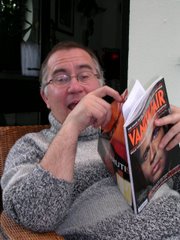
Saturday, 15 December 2007
Purdah time for Wifiwabbit

Saturday, 24 November 2007
The Daily Telegraph | Amazon Kindles the Flames for Books?

It's lightweight, portable, robust, inexpensive. Novel approach: The Kindle can store 200 books and access thousands of newspapers It's so ingeniously simple that the actual book itself - the pages, the glue, the binding, the sleeves - go unnoticed to the user. They are simply the raw materials that allow us to enjoy the most important part of the book - the story it tells."
But with our very modern desire to over-engineer even the most clever designs, it's little wonder that technology companies have been talking for years about the day that "traditional" books will die, and the day that "electronic books" (known as ebooks) will become our preferred reading format.
The death of the book has been mooted for the last decade, but still people stubbornly cling to their dog-eared classics. Amazon, the online retailer, this week launched an audacious bid to change the way we read, with the release of a new ebook reader, called Kindle. Ebook readers are nothing new - Sony's Reader and the iRex iLiad have both been available for a while - but it's the first time a big book seller has thrown its considerable weight behind an ebook project in this way.
Continues ...
http://www.telegraph.co.uk/connected/main.jhtml?xml=/connected/2007/11/22/dlkind22.xml
Tuesday, 20 November 2007
The Daily Telegraph | And the best war film of all time is...
--
Well, the results are in, and there’s been a surprise victory for the Germans: Das Boot has been voted the best war film ever made by Reel Life readers.

The film’s realism was commended above all: “You can almost smell the Diesel,” commented ‘retired’.
The subject of realism divided opinion in the case of Saving Private Ryan, with ‘aeiou’ saying it’s “the most reallistic war film that has ever been made” and ‘BlackArrow’ objecting that “those guys walking out in the open yakking away would have been cut down before the film was half over”.
Films from the World Wars featured heavily in general (though oddly very few people voted for popular classics such as The Great Escape and The Bridge on the River Kwai), but Vietnam only just made it into the top five.
There were also questions raised about what exactly constitutes a war film, with a couple of votes for films like Casablanca and Gone with the Wind thrown in. I counted these, as war certainly does play an important part in them, but there can be no disputing that the films that made it into the top five list are ‘war films’ through and through:
1. Das Boot
2. Zulu
3. Saving Private Ryan
4. The Dam Busters
5. All Quiet on the Western Front and Apocalypse Now
And the best war film of all time is... : November 2007 : Reel Life : Arts : Telegraph Blogs
Saturday, 17 November 2007
The Economist | Banksy - NOT American Graffiti

But his stencils—often of rats making mordant political jokes—have come in from the cold streets to the prosperous warmth of London galleries and auction houses. Record prices for Banksies have been repeatedly set and exceeded over the past nine months.
The rush began in February, when Sotheby's sold seven of Banksy's works in oil, enamel, acrylic and spray-paint. Bonhams took up the baton, and set the pace in April, selling Banksy's “Space Girl and Bird” for £288,000. This autumn, Bonhams has auctioned another 11 Banksies, and Bloomsbury no fewer than 21.
Sunday, 4 November 2007
The Daily Telegraph | Look to Tesco to see the real Britain
But the real Tesco Town is not decked out in vine-ripened tomatoes and cocktail beetroots. There is a windswept office park outside Cheshunt in Hertfordshire which looks like the land that hummus forgot. It is here, in deliberately drab company headquarters, that a small clique of capitalists holds up a mirror to modern Britain.
The reflection we see is not pretty. Our fear of Tesco is almost as endemic as its blue and red signage. Barely a day goes by without a fresh delivery of accusations: that this rapacious retailer is pillaging our farms; homogenising our diet and ethnically cleansing the high street.
Continues ...
Look to Tesco to see the real Britain - Telegraph
Friday, 26 October 2007
The Economist | Twentieth-century music - Music, war and politics intertwined

If only it were that simple, writes Alex Ross, the New Yorker's music critic, in his history of music in the 20th century. He notes that musical life in the past 100 years has “disintegrated into a teeming mass of cultures and subcultures, each with its own canon and jargon.” The cultures may sometimes meet on affable terms, but the results can be comic in their incongruity. In the 1930s, when much of the European artistic elite was holed up in Hollywood, Fanny Brice, a comedienne, strolled over to Schoenberg at a dinner given by Harpo Marx: “C'mon, professor, play us a tune.”
Continues ...
Twentieth-century music Music, war and politics intertwined Economist.com
Saturday, 20 October 2007
The New Yorker | NYCs $$$ via Wall St or SoHo/Chelsea ...?

Continues ...
If You Can Make It Here: Financial Page: The New Yorker

